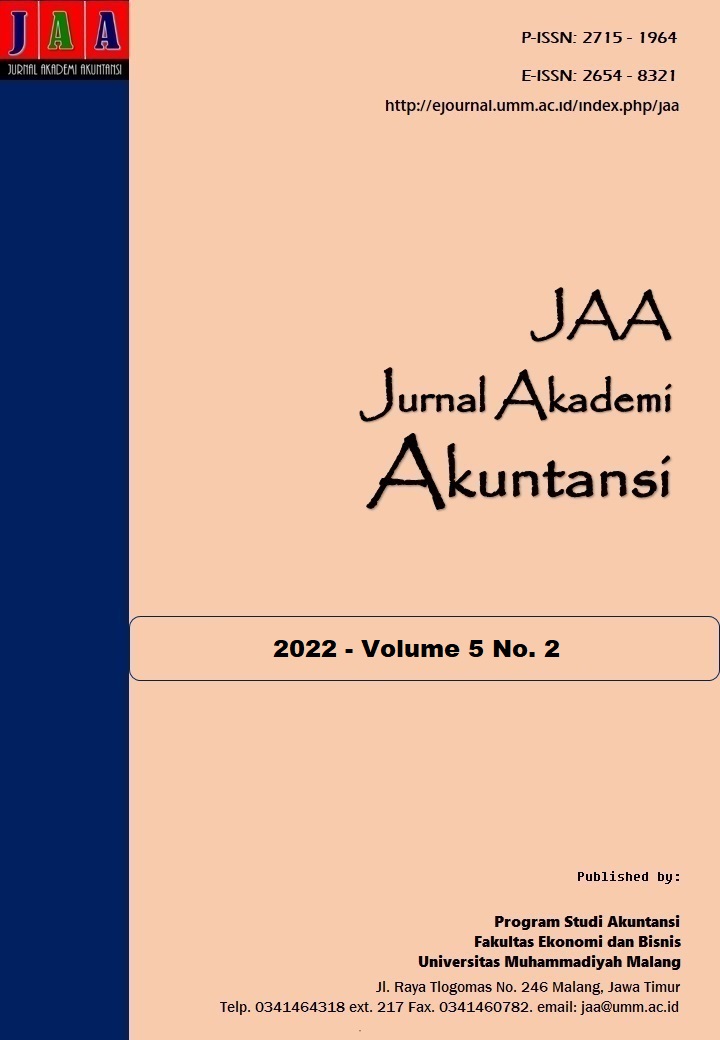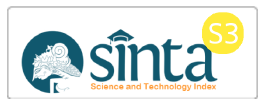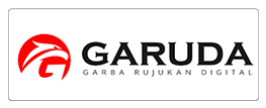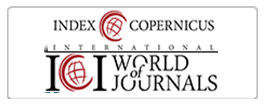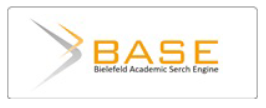Adakah Korelasi Enterprise Risk Management (ERM), Profitabilitas Dan Leverage Keuangan Terhadap Return Saham?
DOI:
https://doi.org/10.22219/jaa.v5i2.18885Keywords:
Enterprise Risk Management (ERM), Financial Leverage, Profitability, Stock ReturnAbstract
Disclosure of Enterprise Risk Management, Profitability and Financial Leverage is an important instrument to provide information to investors, thereby attracting interest in investing in companies that affect the company's stock returns. This study examines the effect of Enterprise Risk Management Disclosure, Profitability, Financial Leverage on Stock Return. The sample in this study using the purposive sampling method was obtained as many as 65 companies from the Manufacturing Sector listed on the Indonesia Stock Exchange in 2020. The data analysis techniques used were descriptive analysis and multiple linear regression analysis. The results of this study indicate that ERM disclosure has no effect on Stock Return, while Profitability and Financial Leverage has an effect on Stock Return. The results of this study indicate that investors in making investments do not pay attention to whether the company's risk management has been managed properly or not. Investors are more concerned with financial information, such as profitability and leverage. Financial information such as profitability and leverage can provide confidence for investors in placing their capital.
Downloads
References
Aditya, O., & Naomi, P. (2017). Penerapan Manajemen Risiko Perusahaan dan Nilai Perusahaan di Sektor Konstruksi dan Properti. Esensi: Jurnal Bisnis Dan Manajemen, 7(2), 167–180. https://doi.org/10.15408/ess.v7i2.4981
Al-Amri, & Davydoy. (2016). Testing the Effectiveness of ERM: Evidence from Operational Losses. Journal of Economics and Business.
Bertinetti, G. S., Cavezzali, E., & Gardenal, G. (2013). The Effect of the Enterprise Risk Management Implementation on the Firm Value of European Companies. SSRN Electronic Journal, August. https://doi.org/10.2139/ssrn.2326195
Dalton, D. R., Hitt, M. A., Certo, S. T., & Dalton, C. M. (2007). The Fundamental Agency Problem and Its Mitigation. Academy of Management Annals, 1(1), 1–64. https://doi.org/10.5465/078559806
Donaldson, T., & Preston, L. E. (1995). THE STAKEHOLDER THEORY OF THE CORPORATION: CONCEPTS, EVIDENCE, AND IMPLICATIONS and from the specific comments of many people, including Professors Aupperle. Academy of Management Review, 20(1), 65–91.
Fadhilah, M., & Sukmaningrum, P. S. (2020). Pengaruh Enterprise Risk Management (Erm), Kinerja Perusahaan Dan Size Terhadap Nilai Perusahaan. Jurnal Ekonomi Syariah Teori Dan Terapan, 7(5), 926. https://doi.org/10.20473/vol7iss20205pp926-939
Hanafi, & Halim. (2009). Analisis Laporan Keuangan. UPP STIM YKPN.
Hanafi, M. M., & Halim, A. (2007). Analisis Laporan Keuangan (5th ed.). UPP STIM YKPN.
Hoyt, R. E., & Liebenberg, A. P. (2011). The Value of Enterprise Risk Management. Journal of Risk and Insurance, 78(4), 795–822. https://doi.org/10.1111/j.1539-6975.2011.01413.x
Iswajuni, I., Manasikana, A., & Soetedjo, S. (2018). The effect of enterprise risk management (ERM) on firm value in manufacturing companies listed on Indonesian Stock Exchange year 2010-2013. Asian Journal of Accounting Research, 3(2), 224–235. https://doi.org/10.1108/AJAR-06-2018-0006
Leland, H. E., & Pyle, D. H. (1977). Informational Asymmetries, Financial Structure, and Financial Intermediation. The Journal of Finance, 32(2), 371–387.
Matar, A., & Eneizan, B. (2018). Determinants of Financial Performance in the Industrial Firms: Evidence from Jordan. Asian Journal of Agricultural Extension, Economics & Sociology, 22(1), 1–10. https://doi.org/10.9734/ajaees/2018/37476
Mohd Tahir, I., & Razali, A. R. (2011). the Relationship Between Enterprise Risk Management (Erm) and Firm Value: Evidence From Malaysian Public Listed Companies. International Journal of Economics and Management Sciences, 1(2), 32–41.
Nuraeni, R., Mulyati, S., & Putri, T. E. (2019). FAKTOR-FAKTOR YANG MEMPENGARUHI PERSISTENSI LABA (Studi Kasus pada Perusahaan Property dan Real Estate yang Terdaftar di Bursa Efek Indonesia Tahun 2013-2015). Accruals, 2(1), 82–112. https://doi.org/10.35310/accruals.v2i1.8
Pakpahan, R. (2010). Pengaruh Faktor-Faktor Fundamental Perusahaan dan Kebijakan Dividen terhadap Nilai Perusahaan (Studi Kasus pada Perusahaan Manufaktur di BEi tahun 2003-2007). Jurnal Ekonomi, Keuangan, Perbankan, Dan Akuntansi, 2(2), 211–227.
Saputro, R., & Badjra, I. (2016). Kinerja Portofolio Saham Berdasarkan Strategi Investasi Momentum Pada Industri Manufaktur. E-Jurnal Manajemen Universitas Udayana, 5(1), 254472.
Sensarma, R., & Jayadev, M. (2009). Are bank stocks sensitive to risk management? Journal of Risk Finance, 10(1), 7–22. https://doi.org/10.1108/15265940910924463
Sulistyaningsih, S., & Gunawan, B. (2018). ANALISIS FAKTOR-FAKTOR YANG MEMENGARUHI RISK MANAGEMENT DISCLOSURE (Studi Empiris Pada Perusahaan Manufaktur yang Terdaftar di Bursa Efek Indonesia Tahun 2012-2014). Riset Akuntansi Dan Keuangan Indonesia, 1(1), 1–11. https://doi.org/10.23917/reaksi.v1i1.1973
Ulum, I., Ghozali, I., & Chariri, A. (2018). Intellectual Capital dan Kinerja Keuangan Perusahaan; Suatu Analisis dengan Pendekatan Partial Least Squares. Simposium Nasional Akuntansi XI, 19(19), 1–31.
Utami, F., & Murwaningsari, E. (2017). Analisis Pengaruh Rasio Profitabilitas Terhadap Return Saham Dengan Kebijakan Dividen Sebagai Variabel Moderasi Studi Empiris Pada Perusahaan Manufaktur Di Bursa Efek Indonesia Periode 2012-2015. Jurnal Magister Akuntansi Trisakti, 4(1), 75. https://doi.org/10.25105/jmat.v4i1.4988
Whiting, R. H., & Miller, J. C. (2008). Voluntary disclosure of intellectual capital in New Zealand annual reports and the “hidden value.” Journal of Human Resource Costing & Accounting, 12(1), 26–50. https://doi.org/10.1108/14013380810872725
Widjaya, P. E., & Sugiarti, Y. (2013). Penerapan Risk Management Untuk Meningkatkan Non-Financial Firm Performance Di Perusahaan Murni Jaya. Jurnal Ilmiah Mahasiswa Universitas Surabaya, 2(1), 1–18. https://media.neliti.com/media/publications/185290-ID-none.pdf
Downloads
Published
Issue
Section
License
Copyright (c) 2022 Endang Dwi Wahyuni

This work is licensed under a Creative Commons Attribution-NonCommercial-ShareAlike 4.0 International License.
Jurnal Akademi Akuntansi is licensed under a Creative Commons Attribution-NonCommercial-ShareAlike 4.0 International License.
Authors who publish with this journal agree to the following terms:
- Authors retain copyright and grant the journal right of first publication with the work simultaneously licensed under a Creative Commons Attribution-NonCommercial-ShareAlike 4.0 International License that allows others to share the work with an acknowledgment of the work's authorship and initial publication in this journal.
- Authors are able to enter into separate, additional contractual arrangements for the non-exclusive distribution of the journal's published version of the work (e.g., post it to an institutional repository or publish it in a book), with an acknowledgment of its initial publication in this journal.
- Authors are permitted and encouraged to post their work online (e.g., in institutional repositories or on their website) prior to and during the submission process, as it can lead to productive exchanges, as well as earlier and greater citation of published work (See The Effect of Open Access).
Jurnal Akademi Akuntansi dilisensikan di bawah lisensi Creative Commons Attribution-NonCommercial-ShareAlike 4.0 International.
Penulis yang menerbitkan artikel di jurnal ini menyetujui ketentuan berikut:
- Penulis mempertahankan hak cipta dan memberikan hak jurnal atas publikasi pertama dengan karya yang secara serentak dilisensikan di bawah Lisensi Pengaitan Creative Commons yang memungkinkan orang lain untuk berbagi karya dengan pengakuan atas karya penulis dan publikasi awal dalam jurnal ini.
- Penulis dapat masuk ke dalam pengaturan kontrak tambahan yang terpisah untuk distribusi non-eksklusif versi karya jurnal yang diterbitkan (misalnya, mempostingnya ke repositori institusional atau mempublikasikannya dalam sebuah buku), dengan pengakuan publikasi awalnya di jurnal ini.
- Penulis diizinkan dan didorong untuk memposting pekerjaan mereka secara online (misalnya, di repositori institusional atau di situs web mereka) sebelum dan selama proses pengajuan, karena dapat mengarah pada pertukaran produktif, serta kutipan pekerjaan sebelumnya dan yang lebih besar (Lihat Pengaruh Akses Terbuka).

